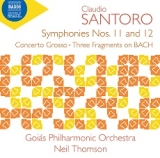Nachdem Claudio Santoro (1919-1989) knapp zehn Jahre an der Staatlichen Hochschule für Musik Heidelberg-Mannheim als Dozent für Komposition gewirkt hatte, kehrte er 1978 nach Brasilien zurück, um dort den neu geschaffenen Posten als Dirigent am Nationaltheater in Brasilia anzunehmen. In dem folgenden letzten Jahrzehnt erwies er sich als äußerst produktiv. Aus dieser Zeit stammen die auf dieser CD zu hörenden Werke. Nachdem er zwei Jahrzehnten lang radikal experimentiert hatte, in denen er zwischen Serialismus, Aleatorik und elektroakustischer Musik wandelte, wurde sein Stil in diesen letzten Jahren traditioneller. Mit eklektischer und sehr persönlicher Sprache führte er eine Art künstlerischer Synthese seiner früheren Erfahrungen herbei.
Das Concerto Grosso, sein erstes dann in Brasilien geschaffenes Werk, ist mit Clustern und Aleatorik durchsetzt. Ein Streichquartett übernimmt die Rolle der Solisten gegenüber dem Tutti des Orchesters.
Die Elfte Symphonie ist die kürzeste, dichteste und dramatischte seiner Symphonien. Nach trostlosem Einstieg folgt ein energiegeladenes intensives Allegro, bevor ein Violinsolo die trostlose Atmosphäre des Anfangs zurückbringt. Der zweite Satz, ein lebhaftes Scherzo, verlangt den Bläsern Virtuosität ab. Im Finale explodiert der vorher geschaffene Konflikt. Die tragische Stimmung erinnert an Brahms‘ Erste Symphonie – einem von Santoros Lieblingskomponisten.
Auch in den Drei Fragmenten über BACH zum 300. Geburtstag von Johann Sebastian Bach herrscht die Angst vor. Santoro bearbeitet das B-A-C-H-Motiv (deutsche Notation: B-A-C-B) sowohl melodisch wie durch Transposition, Umkehrung, serielle und retrograde Techniken.
Eine frühere Komposition bildete die Grundlage für seine 12. Symphonie, was sich im Untertitel ‘Sinfonia concertante für acht Instrumente und Orchester’ erhalten hat; die Posaune kam als neunte Solistin hinzu. In jedem Satz sind ein oder mehrere der Soloinstrumente aktiv.
Auf ihrer Erkundungsreise zu wichtiger brasilianischer Musik legen das Goiás Philharmonic Orchestra und sein Chef Neil Thomson, auch andere Beteiligte arbeiten an dieser 100 Werke umfassenden Reihe mit, wieder Musik von Claudio Santoro vor. Erneut beweisen sie ihr Gespür für die Musik ihrer Heimat, die in hier mit Einflüssen von Bach und Brahms angereichert ist. In dieser Folge werden die kammermusikalischen Aspekte stärker betont und zeigen, dass auch die einzelnen Musiker und nicht das Orchester sich hören lassen können. Mit drei Ersteinspielungen, neben den Bach Fragmenten, eröffnet sich eine beschwingte und spannende Reise zu in Europa weitgehend unbekannten Tönen.
After teaching composition at the Staatliche Hochschule für Musik Heidelberg-Mannheim for nearly ten years, Claudio Santoro (1919-1989) returned to Brazil in 1978 to accept the newly created post of conductor at the National Theater in Brasilia. In the following last decade he proved to be extremely productive. The works heard on this CD date from this period. After two decades of radical experimentation, during which he wandered between serialism, aleatoricism and electroacoustic music, his style became more traditional in these last years. With eclectic and very personal language, he brought about a kind of artistic synthesis of his earlier experiences.
Concerto Grosso, his first work then created in Brazil, is interspersed with clusters and aleatorics. A string quartet takes the role of soloists against the tutti of the orchestra.
The Eleventh Symphony is the shortest, densest and most dramatic of his symphonies. A bleak opening is followed by an energetic intense Allegro before a violin solo brings back the desolate atmosphere of the beginning. The second movement, a lively scherzo, demands virtuosity from the winds. In the finale, the conflict created earlier explodes. The tragic mood recalls Brahms’s First Symphony – one of Santoro’s favorite composers.
Anxiety also prevails in the Three Fragments on BACH for the 300th anniversary of Johann Sebastian Bach’s birth. Santoro reworks the B-A-C-H motif (German notation: B-A-C-B) both melodically and through transposition, inversion, serial and retrograde techniques.
An earlier composition formed the basis for his 12th Symphony, which survives in the subtitle ‘Sinfonia concertante for eight instruments and orchestra’; the trombone was added as the ninth soloist. One or more of the solo instruments are active in each movement.
In their exploration of important Brazilian music, the Goiás Philharmonic Orchestra and its principal Neil Thomson, with other participants also collaborating on this 100-work series, again present music by Claudio Santoro. Once again they demonstrate their feel for the music of their homeland, enriched here with influences from Bach and Brahms. In this set, the chamber music aspects are emphasized more strongly, showing that the individual musicians, rather than the orchestra, are also worth listening to. With three premiere recordings, in addition to the Bach fragments, an upbeat and exciting journey to sounds largely unknown in Europe opens up.






















